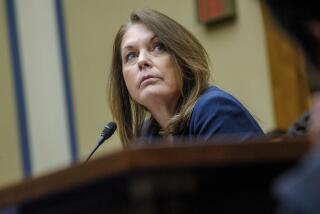Louis Caldera resigns over Air Force One flyover fiasco
- Share via
WASHINGTON — An Obama administration official who took the blame for the Air Force One flyover in Lower Manhattan last month gave his resignation Friday, after a White House investigation into a botched photo op that frightened New Yorkers with its echo of the Sept. 11 attacks.
Louis Caldera, a former California assemblyman from Los Angeles, wrote to the president that he could no longer perform effectively as head of the White House Military Office. In his letter, Caldera said the episode had “become a distraction to the important work you are doing as president.”
The White House released Caldera’s letter along with its seven-page review late Friday afternoon.
The April 27 flight was intended to get a publicity picture of the plane above the Statue of Liberty. Obama was not aboard at the time. The public had not been forewarned, leaving some to worry that the plane, flying at 1,000 feet, might be targeting a skyscraper. Some people fled high-rise buildings, thinking they were under attack.
Defense Secretary Robert M. Gates estimated that the trip cost taxpayers $328,835.
After the flight, White House officials described Obama as “furious.” Caldera, secretary of the Army under President Clinton, quickly issued an apology and took responsibility for “any distress that flight caused.”
The White House investigation of the incident, led by Deputy Chief of Staff Jim Messina, suggests that military and political aides up and down the chain didn’t imagine the photo op would backfire. The report also shows that high-level officials had differing recollections about what they had been told about the flight.
Planning for the flyover began in March or earlier, the review shows. On April 20, George Mulligan, deputy director of the Military Office, told investigators that he had notified Caldera about the plans. The report said that Caldera, a political appointee, did not recall that conversation.
A military official who runs the unit that oversees presidential travel told Mulligan in an April 23 e-mail that federal, state and local authorities would be notified of the flight the next day. And “coordination with the general public would begin on or after” April 26 -- the eve of the flight.
Mulligan sent Caldera an e-mail on April 24 telling him about the flight and suggesting he mention it to Messina or Robert Gibbs, the White House press secretary. But Caldera told investigators he didn’t read that e-mail until after the flight because he’d just returned from a presidential trip to Mexico and had left work early with back spasms, the report said.
The same day, Mulligan told Caldera in person about the flight plan, suggesting he notify Messina and Gibbs. In the end, Caldera never told either one about the flight. The report said that he “did not offer a coherent explanation” when asked why.
“He stated that it was not a conscious decision,” the report said, and that he didn’t realize “that Air Force One would be flying over Lower Manhattan at a very low altitude.”
When the news media reported on the uproar in Manhattan, the officials who knew about the flight plans were surprised, the report showed.
“In [Mulligan’s] view, the breakdown was the lack of public notification,” the report said. Others thought the Federal Aviation Administration “had taken the lead on public affairs and coordination.”
--
More to Read
Sign up for Essential California
The most important California stories and recommendations in your inbox every morning.
You may occasionally receive promotional content from the Los Angeles Times.












